New Nordic Cuisine: It put Copenhagen on world gastro map but at what cost? Too much for this travel writer
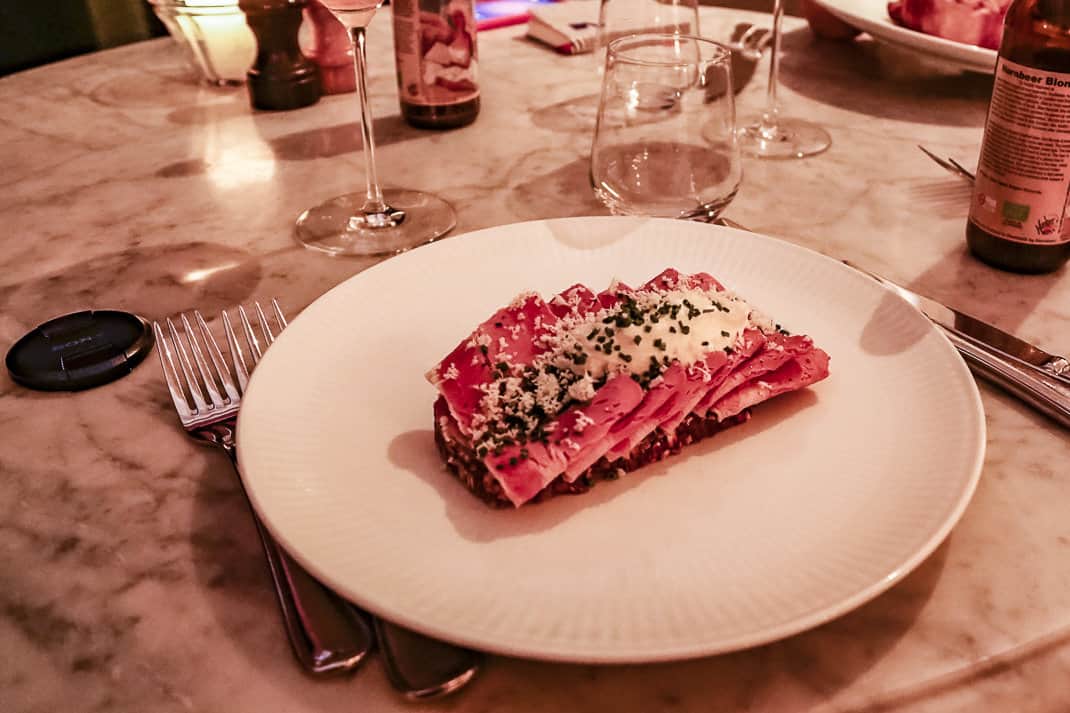
COPENHAGEN, Denmark – The plates were deep and round and the size of catchers mitts. They seemed fitting for the restaurant’s elegant yet hip surroundings. Copper, multi-limbed lights hung from the ceiling. Op-art paintings decorated the walls. A well-dressed, professional crowd filled every table on the black-and-white checkered floor.
Palaegade is part of Copenhagen’s New Nordic Cuisine, a genre of 21st century restaurants that has made Denmark’s capital one of the hottest restaurant cities in the world over the last 10 years. It’s why we came two weeks ago.
We wanted to eat our way across Copenhagen. It was our first night in town and Marina ordered tuna. I ordered halibut, both part of that New Nordic Cuisine emphasizing healthy, natural products from local land and sea.
Marina looked down at her plate. She didn’t look up. For a few seconds, she seemed to be searching. Her tuna was hidden – somewhere – under a small dollop of vegetables. She gazed up, with a woeful, wanton look in her eyes. She reminded me of her cat, Coco, when he sees his food bowl is empty.
I looked at my plate. A cold, hard piece of kale covered my itty-bitty piece of cold halibut that would leave even Coco ordering pizza delivery. Marina finished her fish in four bites; I took three. If it wasn’t for the excellent warm, homemade bread, we’d have raced to our room for the paninos we’d packed in Rome for the trip.
Then came the bill and we lost our appetites. The two dishes, plus two glasses of Sauvignon Blanc from France, were 550 Danish kroner, or €74. They charged us 70 DKK (€9.50) for water.
It got worse. The next day for lunch at a place called Salon, two open-faced sandwiches, called smorgasbord, and two beers were 720 DKK (€97). That water was 100 DKK (€13.50).
I wanted to ask if the bills come with a lubricant.

New Nordic Cuisine
Copenhagen has a legit reason to be in the world’s gastro elite. Fifteen restaurants have earned a total of 24 Michelin stars. The problem with Michelin stars is they give restaurants license to jack up prices to the level of American surgery on vital organs.
We took the cheaper options off the a la carte menus. Most popular in Copenhagen are the fixed-priced menus. These range from three to 20 courses that are a minimum of €100 per person and as high as €600. Marina doesn’t eat enough to warrant a fixed-price menu; I’m retired and don’t want to be broke on the banks of the Tiber, gnawing dry fusilli and babbling about the evils of social democracies.
The masterminds behind New Nordic Cuisine are Claus Meyer, a Copenhagen TV chef and businessman, and Rene Redzepi, a renowned Danish chef who had worked at the famed Michelin-star French Laundry in Yountville, Calif. In 2003, Meyer co-founded Noma (an abbreviation of the Danish words “nordisk” for Nordic and “mad” for food) and hired Redzepi as his chef.
In 2004, they held a conference with some of the top chefs in the Nordic region. They wanted to change Nordic cuisine, using “only things you can watch from your window,” as one food writer wrote.
Previously, Nordic food had been a culinary wasteland. Expensive and dull, it was berries, roots and breads with seafood thrown in. Pickled herring was huge.
The men gathered and came up with the New Nordic Kitchen Manifesto. It’s a guideline of 10 goals that would make New Nordic Cuisine as popular as Scandinavia’s scenery. They are the 10 commandments of Nordic cooking. They range from No. 1: “To express the purity, freshness, simplicity and ethics that we would like to associate with our region” to No. 10: “To cooperate with representatives of consumers, other cooking craftsmen, agriculture, fishing industry, food industry, retail and wholesale industry, researchers, teachers, politicians and authorities on this joint project to the benefit and advantage of all in the Nordic countries.”
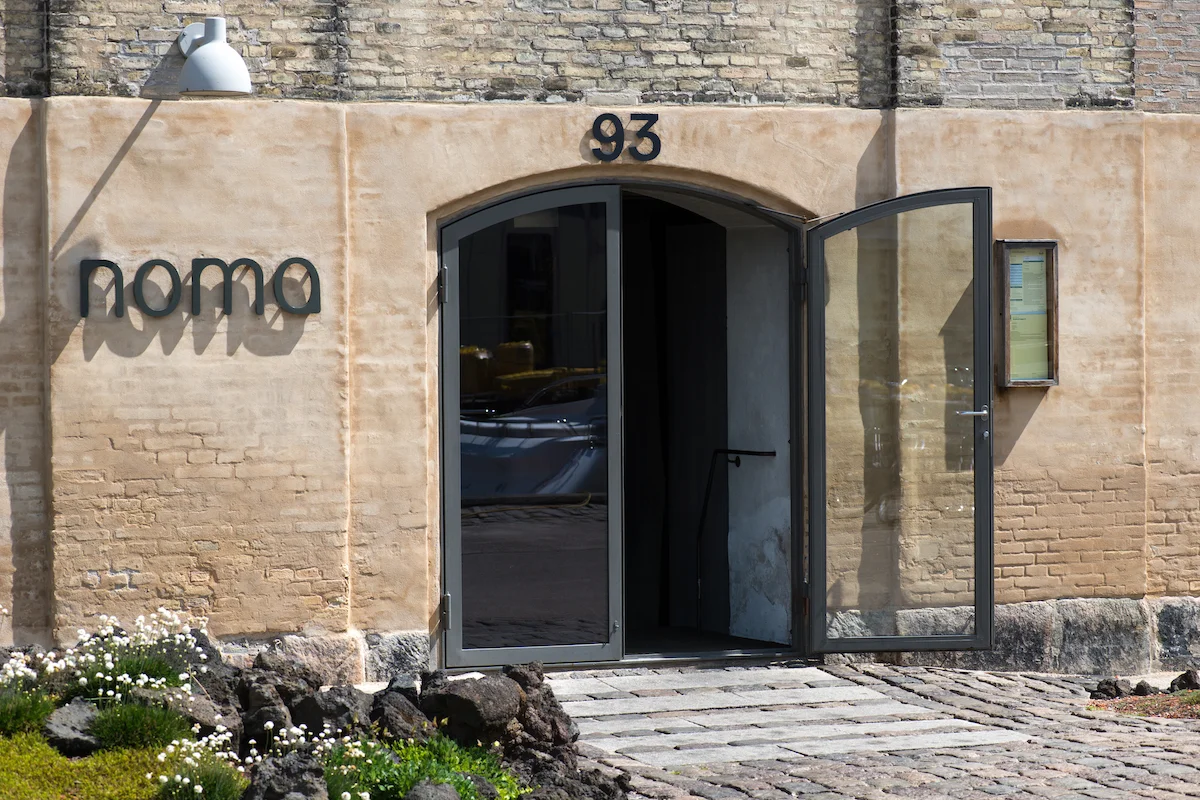
The idea exploded. With an emphasis on foraging, creativity and interpretation, Noma served dishes such as langoustines on a craggy rock, air-dried sea buckthorn and pickled ramson flowers.
It was named Best Restaurant in the world by Restaurant magazine in 2010, 2011, 2012 and 2014. In 2021 it earned the top spot in the World’s 50 best Restaurant Awards list. Redzepi made the cover of Time magazine twice.
Noma has earned three Michelin stars and while Redzepi has remained, 20 chefs who worked under him have left and opened their own restaurants. They followed the same theme: creative dishes, natural ingredients, fixed-price menus and prices that oft ask for your first-born male child.
I met one person in Copenhagen who’d eaten there twice. It cost him 5,000 DK or €675. It had 22 courses. It took three hours. You are advised not to go to the bathroom as the dishes come that fast. It is sold out every night and has been for the last 10 years. They release their available tables three months in advance.
“It was like I had watched this amazing movie or went to the theater,” he said. “It was the closest to art except it was food.”
Soon came other restaurants. Barr moved into Noma’s old space and serves dishes such as salted waffles and Danish meatballs. Ark, a Vegan restaurant, earned a Michelin Green Star for its plant-based seasonal tasting menu. Every ingredient comes from within two hours of the property delivered by bike. At Gro Spiseri, Denmark’s first rooftop farm restaurant, you eat at long communal tables in a greenhouse or outside among heads of cabbage and lettuce.
In doing research, I noticed few articles mentioned price or portions. But the cherry & beetroot granita is divine!

Palaegade
I didn’t suffer sticker shock. Even in January you need reservations in Copenhagen. Back in Rome I perused restaurant websites and saw fixed-priced menus priced more for oil sheikhs than retired sportswriters.
So when we walked into Palaegade, which earned a Michelin star in 2021, I didn’t panic when I saw the four-course menu set at 750 DKK (€100) with wine pairings. I’m sorry but I don’t like roasted langoustine with pumpkin, vadouvan and yuzu sauce that much.
The waiter advised us, “You can have the four-course fixed price or go a la carte and build your own menu.”


The menu descriptions make you think you’re getting a meal. It listed my dish as “Salted halibut with oyster emulsion, Thai basil, crispy kale and horseradish.” Marina’s read, “Hamachi tuna with X.O. (high-end sauce originally from Hong Kong), citrus fruits and lime leaf oil.” Sounds like they could feed a village, right?
They couldn’t feed a hamster. We’ve had antipasti in Italy with more food. If we had enough a la carte items to feed us, the bill would’ve been €200.
I’d been appalled at restaurant prices in Iceland, where the lone places in villages charged $35 for a piece of fish and $28 for a hamburger. But at least I didn’t walk away hungry.
I left Palaegade wondering if I packed enough protein bars.

Salon
The next day, Salon was a step up. It opened in 2018 in the Frederiksstaden neighborhood dripping with rococo architecture. Modern art of kitchen scenes decorated Salon’s walls. We were early but within an hour all the elegant tables were filled.
Salon is one of the many places specializing in smorgasbord. It has an entire page of these open-faced sandwiches, ranging from curry herring, curry cream and poached egg to duck liver terrine, apricot, Sauternes wine and brioche. I had the veal brisket with horseradish cream and pickled cucumbers. It was good – but small. It was six thinly cut slices of beef on a single slice of mild rye bread with very nice horseradish cream.
Marina had the salmon from Samso, a Danish island, with shrimp and dill cream on a croissant. Both were about the size of a six-inch Subway sandwich. Mine was 185 DKK (€25); hers was 195 (€26).
Later back in the room, I examined the bill. The three beers at 80 DKK (€11) each didn’t surprise me. Something else jumped off the piece of paper like a ransom note. Marina had asked for a glass of water. They charged us 50 DKK (€7) each. That’s €14 for a bottle of water.
I later wrote Salon and asked why. They said – and this is true – charging a lot for water is common in Denmark.
“There are a lot of costs for us in serving water,” wrote Alexandra Yoirke Penny Assens. “We need to buy bottles, water glasses, a filtering system, a water tap system, gas for sparkling water, soap and salt for the dishwashing machine, salary for the dishwasher, etc. etc. so even though it’s ‘only’ water, it is quite pricey to serve.”
That’s funny. Rome restaurants go through the same process and we pay no more than €4. Or I can get tap water for free. I asked if they had raised their prices due to Covid increasing the cost of production. She said they had not but there’s a reason they remain expensive.
“Salon has always only used the best produce available, and we do what we can to buy locally farmed produce where we know which quality we’ll get,” she wrote. “This means that Salon has always, price wise, been in the upper range, which we still are.”
I invited a well-known Copenhagen restaurant critic to meet me after lunch. (Notice the word “after.” I learned quickly I couldn’t pay for an extra guest.) He didn’t want his name used but cautioned my tale of financial hardship. He said the center of Copenhagen is the most expensive place in Denmark.
I also knew that Denmark’s average salary is among the top 10 in the world. According to the Average Salary Survey, it’s 660,748 DKK, about €89,000 a year. However, the basic premise of any eatery since the beginning of time, from country diners to Michelin-rated restaurants, is to feed people.
In Copenhagen we were not. Due to costs and being there only three days, we limited our research. Maybe in the outer neighborhoods we’d have better luck. We went to a utilitarian Thai place called Scurry Hub that was good and filling and I got out of there for about €30.

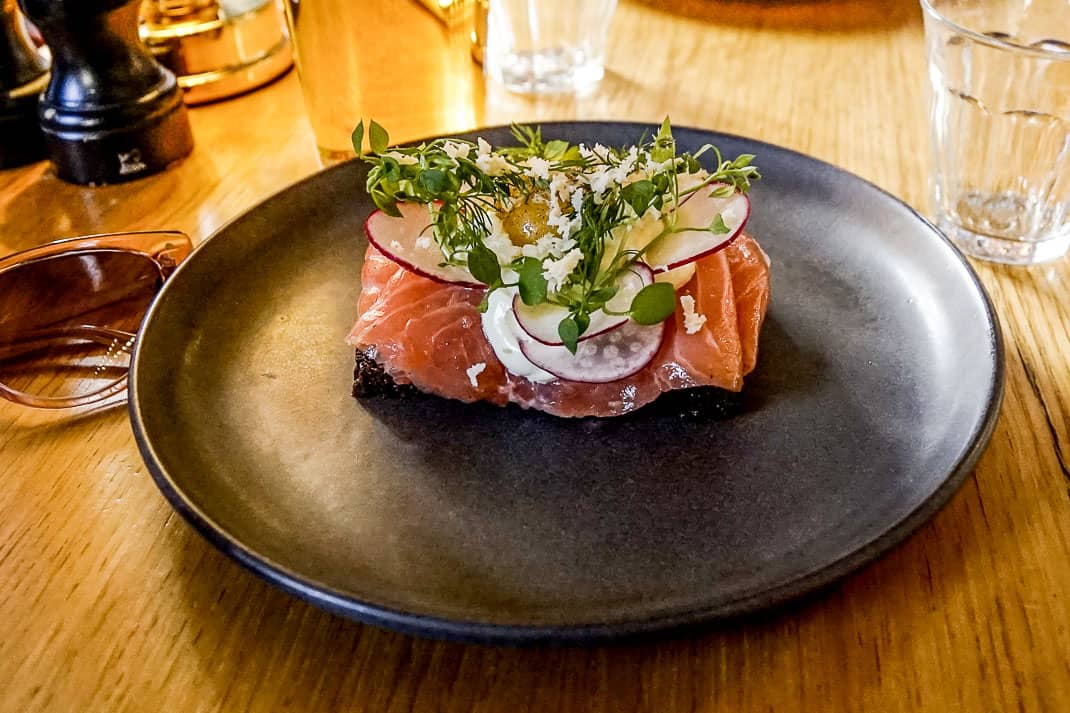
We also found a cheaper smorgasbord at Maven, an elegant, eight-year-old restaurant in the Royal Quarter neighborhood where soft piano music played. I had butter-fried fish filet with lingonberries, lemon and remoulade and Marina had home-smoked salmon with egg yolk confit, horseradish and lemon mayo. I got out of there for 420 DKK (€50), by far the best meal we had in Copenhagen.
But how is this trend of small, very expensive dishes sustainable? Eating becomes a challenge, a hardship. Food is part of the travel experience. I learn so much about a culture just by eating. A cuisine defines a people.
New Nordic Cuisine defines Danes as rich and trendy. Trendy doesn’t feed the hungry. Rob Anderson, a chef and owner of a restaurant in Provincetown, Mass., also took New Nordic Cuisine to task in The Atlantic this month.
“The truth is that the kind of high-end dining Noma exemplifies is abusive, disingenuous, and unethical,” he wrote. “Chefs know it but continue to imitate Redzepi. The food media know it but continue to celebrate his kind of food. Wealthy diners know it but continue to book tables en masse – if not at Noma, then at comparable destination restaurants around the world.”
Mikkel Sorensen is the manager at our Hotel Astoria, Copenhagen’s first elegant hotel and whose excellent buffet breakfast we learned to pork out at every morning. He ran a restaurant in Denmark’s Jutland region in 2020-21.
He’s not a fan of artsy food that belongs more on a wall than on a plate.
“It’s their take on it,” he said. “It has become small, pretentious in a way. And I don’t think it’s right. I think it’s sad. It’s the wrong turn where it’s going, especially for Danes because Danes want to have food. They’re into value and getting what they pay for.
“A lot of it is social media. People are more busy taking pictures of the food. That’s a trend in Copenhagen. It’s more fun to say you’ve been there and eaten there than actually having a good experience.”
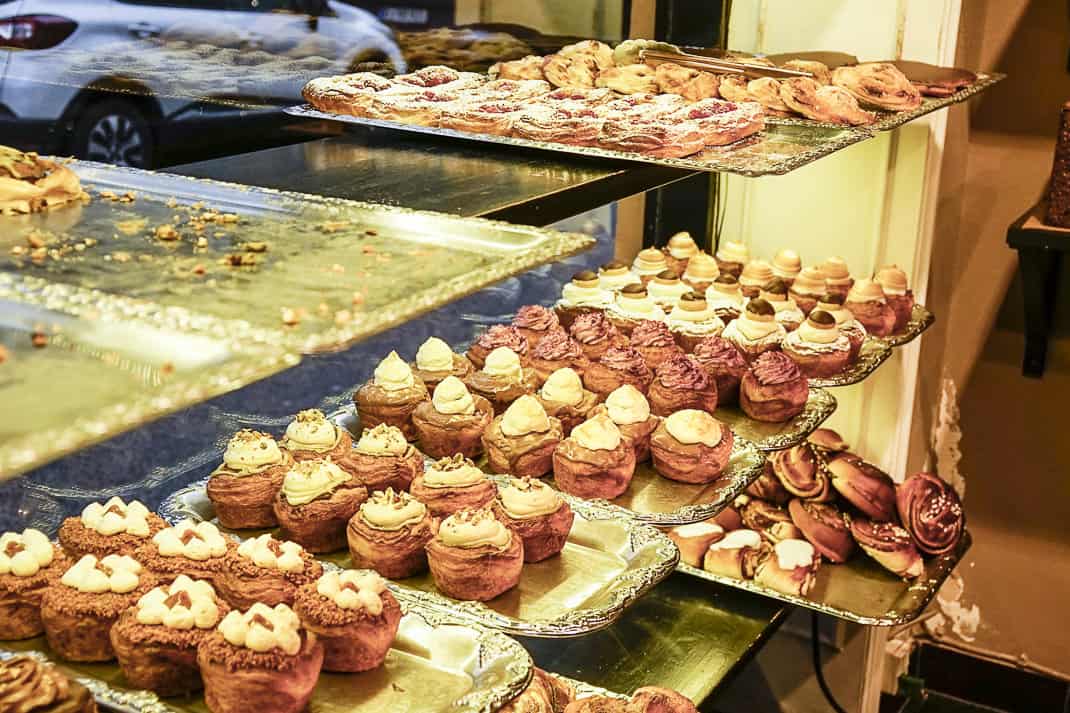
Danish pastry
After three days, I think the best part about Danish cuisine is what has been its trademark. Danish pastry is not a cliche. It is legit and always has been. It always will be. In my only other trip to Denmark in 1978, I was on the $15-a-day backpacker bandwagon and made the bakery beeline every morning. Cherry crullers. Chocolate croissants. Donuts.
Actually, Danish pastry came from Austria. In the 19th century, Denmark had a bakery strike and restaurants recruited chefs from Vienna who started making pastries you can find in Austria today. In recent years, Copenhagen has experienced a pastry boom as after Covid slowed, Danes curiously developed a craving for sweets.
In fact, four chefs left Noma to start bakeries.
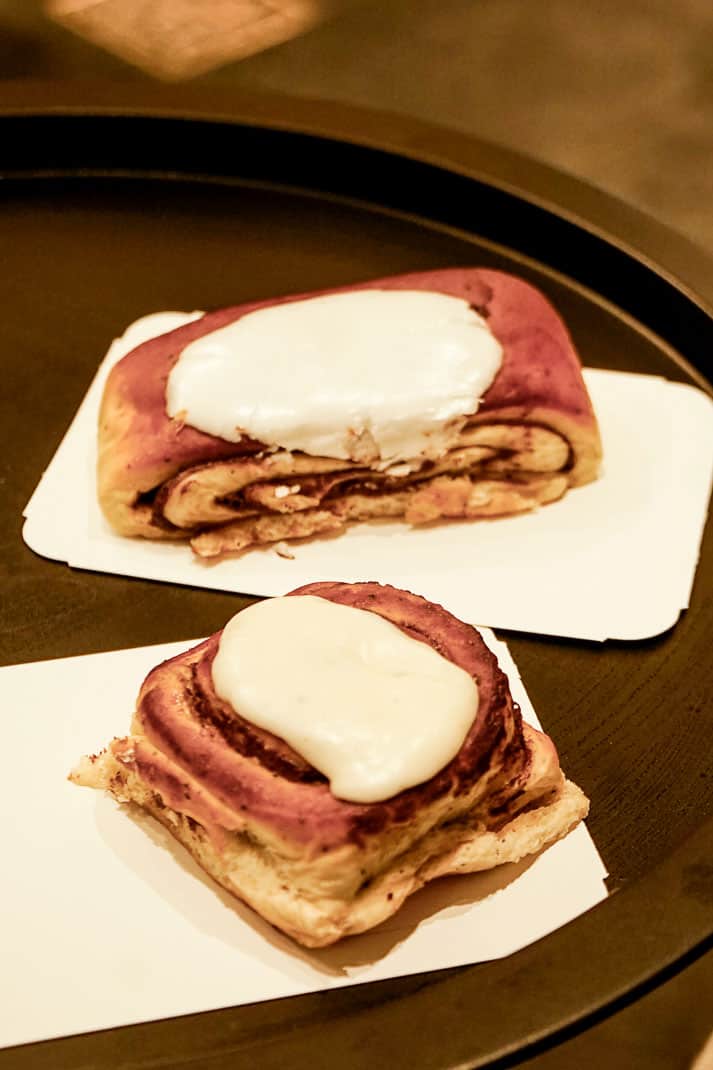
We found Sankt Peders Bageri, which opened 23 years ago, on a quiet street near Orstedsparken, the 6.5-hectare (16-acre) park not far from our hotel. The display cases made our mouths water. Big thick cinnamon rolls with a generous portion of white frosting beckoned us inside. For 25 DKK (€3.50) each, we had simply the greatest cinnamon rolls ever produced by human hands. Soft, sweet and savory, we went back again to get two more.
We saved them for the inevitable hunger pains later.
I love Copenhagen and would return. The beauty of the city, the kindness of the people, the liberalism of the culture, that’s all free. But I wonder how long New Nordic Cuisine can last. Earlier this month Noma announced that it will close at the end of 2024 and become more of a food lab. Turns out, paying 42 cooks (one per diner) Copenhagen wages affects the bottom line, even if Noma has been charged with not paying its army of interns.
But a food lab from a place that already serves sea buckthorn? I’ll pass on being a guinea pig.
Eating in Copenhagen can be managed financially. Hit the small ethnic restaurants. Get out of the city center. Bring lots of protein bars. But there’s a plus side in having expensive, boutique cuisine.
As Marina said, “No wonder Danes are so thin.”

If you’re thinking of going …
How to get there: You can fly round trip from London to Copenhagen as cheap as $70 on Ryanair. I paid €133 on Ryanair for my round-trip flight from Rome.
Where to stay: Hotel Astoria, Banegardspladsen 4, 45-44-40-1001, https://www.hotelastoria.dk, hello@hotelastoria.dk. Built in 1935, Copenhagen’s first luxury hotel is across the street from the train station and still has trappings of the early 1900s. I paid €117 a night.
Where to eat: Maven, Nikolajplads 10, 45-3220-1100, www.restaurantmaven.dk, booking@restaurantmaven.dk, 11:30 a.m.-11:55 p.m. Monday-Saturday. Stylish restaurant near the Royal Quarter with excellent selection of smorgasbord sandwiches at relatively sane prices. I paid €58 for lunch for two.
Sankt Peders Bageri, Sankt Peders Straede 29, 45-33-11-1129, https://www.instagram.com/sct.pedersbageriogkonditori/?utm_medium=copy_link, 7:30 a.m.-5 p.m. Monday-Saturday. All kinds of classic Danish pastry from cinnamon rolls to cream-filled croissants. A cinnamon roll with white frosting is 25 DKK (€3.50).
When to go: Summers are mild and due to the high costs, Denmark gets fewer tourists than much of Western Europe. Average high temperature in July and August is 71. In January, temperatures range from 31-38.
For more information: Copenhagen Information Centre, Vesterbrogade 4A, 45-7022-2442, www.visitcopenhagen.com, 9 a.m.-4 p.m. Monday-Friday, 10 a.m.-3 p.m. Saturday-Sunday. Has a cafe and lounge.


January 31, 2023 @ 3:05 pm
Thanks for this timely review. Really enjoyed it! We’ve been planning on a Scandinavian tour in late summer for a long time and might make it this year. We are not a fan of Michelin starred restaurants, and my Italian husband is definitely not a fan of any cuisine that is qualified by “new” or “nouvelle”. He needs to see the food on his plate without a magnifying glass.
January 31, 2023 @ 3:33 pm
Was thinking about how you don’t see many obese people in Denmark and then read Marina’s comment!! Great pic of you both!!
January 31, 2023 @ 5:50 pm
Fascinating research and totally alarming trend. I felt hungry reading your report! Very happy to be in Alba and enjoying delicious & generous local food and wine at very reasonable prices.